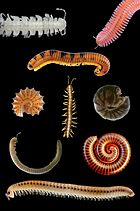| Archipolypoda Temporal range: | |
|---|---|
 | |
| Reconstruction of Acantherpestes major | |
| Scientific classification | |
| Domain: | Eukaryota |
| Kingdom: | Animalia |
| Phylum: | Arthropoda |
| Subphylum: | Myriapoda |
| Class: | Diplopoda |
| Subclass: | Chilognatha |
| Superorder: | † Archipolypoda Scudder, 1882 |
| Orders | |
Archidesmida Contents | |
| Synonyms | |
Macrosterni Fritsch, 1899 | |

Archipolypoda is an extinct group of millipedes known from fossils in Europe and North America and containing the earliest known land animals. [1] The Archipolypoda was erected by Scudder (1882) [2] but redefined in 2005 with the description of several new species from Scotland. [3] Distinguishing characteristics include relatively large eyes with densely packed ocelli (sometimes interpreted as compound eyes), and modified leg pairs on the 8th body ring. [3] [4] Some species had prominent spines while others had a flattened appearance. [3] [5]

